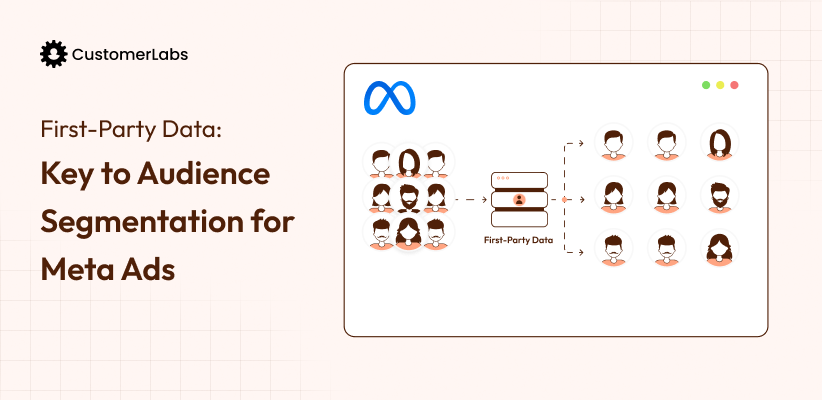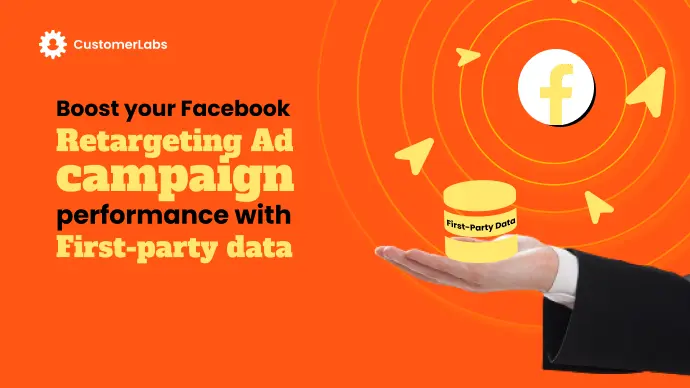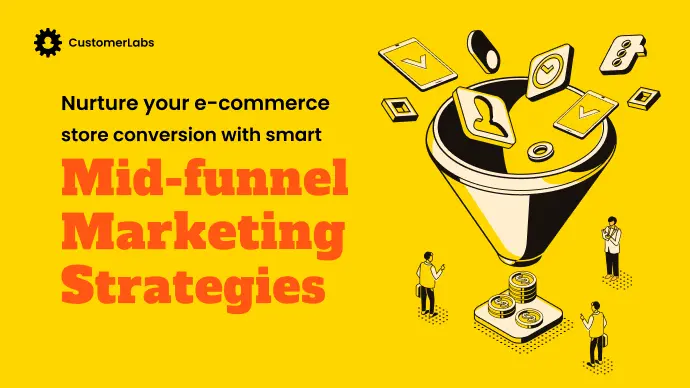Ever wondered why your e-commerce ad performance keeps dipping even though your budget hasn’t changed?
It’s not that your product suddenly got less appealing; it’s that your audience got too broad.
In today’s hyper-competitive e-commerce landscape, generic ads are like shouting into a crowded marketplace. Successful brands have realized that growth no longer comes from reaching more people, but from reaching the right people, this is where audience segmentation comes into the play.
Audience segmentation for ecommerce business helps group your customers based on who they are, what they do, and what drives them to buy. When you tailor your campaigns around these insights, every ad dollar works harder; increasing CTRs, conversions, and even long-term customer value.
In this guide, we’ll break down:
- The key types of customer segmentation every e-commerce marketer should know
- Actionable frameworks and hacks to apply segmentation across Meta, Google, and email campaigns
- How to measure and scale your segmented campaigns for sustainable performance
- And finally, the best tool that you can use for granular and precise audience segmentation for your ecommerce brands.
Drum roll to begin.
What is Audience Segmentation in E-commerce?
Audience Segmentation (Customer/user segmentation) is a process of dividing your entire customer base into smaller, meaningful groups based on shared traits such as their shopping behavior, purchase history, demographics, or even motivations to buy.
In simple terms: segmentation helps you stop treating every visitor like a first-time buyer.
- When done right, it helps you answer three critical questions:
- Who are my most valuable customers?
- What do they care about most when buying?
- How can I reach them at the right moment with the right message?
For e-commerce brands, segmentation is the missing link between data and performance. It transforms raw analytics into actionable audience groups that you can target across your ad platforms like Meta, Google, etc,. to create campaigns that actually convert.
Why Segmentation Matters Now More Than Ever
With rising ad costs, stricter privacy rules, and the end of third-party cookies, marketers can no longer rely on broad targeting. The only reliable edge left is how well you understand your own audience, aka, your first-party data.
Here’s what effective segmentation does for your e-commerce growth:
- Improves ad efficiency: no wasted spend on people who’ll never buy.
- Increases conversion rates: relevant offers convert faster.
- Boosts retention & lifetime value: customers feel recognized and valued.
- Drives smarter personalization: creative and messaging that fit each user’s stage in the journey.
In short, segmentation helps you stop chasing more clicks and start creating more loyal customers. Next, let’s read more about the types of audience segmentation.
Also read on: How 1P data Powers your Audience Segmentation Strategy

6 Most Common Types of Audience Segmentation for E-commerce
Every e-commerce marketer collects data but not everyone uses it to truly segment their audience. Let’s break down the most impactful segmentation types for e-commerce brands.
1. Demographic Segmentation: Know Who You’re Talking To
This is the most basic yet powerful form of segmentation.
You divide customers based on demographic data such as age, gender, income, education, and occupation.
For example: A skincare brand might target Gen Z women with “acne control” campaigns while showing anti-aging products to women above 35.
Different demographics have different motivations, pain points, and price sensitivities and when your creative speaks directly to that, engagement and conversions shoot up.
2. Geographic Segmentation: Location Drives Relevance
Geography plays a huge role in buying behavior especially for seasonal products or brands with regional audiences. This segmentation is based on country, state, city, climate, or even cultural preferences.
For instance, a brand selling fitness gear could highlight “Free Same-Day Delivery in Delaware” to boost local trust and conversion.
Localized campaigns improve CTR and reduce wasted impressions. Plus, people trust brands that feel local.
3. Behavioral Segmentation: Actions Speak Louder Than Demographics
This is where things get powerful.
Behavioral segmentation groups users based on how they interact with your brand, like the actions that they make. Like pages viewed, time spent, frequency of purchase, average order value, or even abandoned carts.
You can take examples like:
- Retarget cart abandoners with “Still thinking? Grab 10% off” ads.
- Show loyalty ads to customers who’ve purchased 3+ times in 6 months.
- Target high-AOV buyers with premium product bundles.
Behavioral segments directly impact your ad ROI because you’re targeting based on intent and action, not just identity.
4. Psychographic Segmentation: Understand the Why
Psychographics dig deeper, look beyond what people buy and uncover why they buy.
This includes their values, interests, personality traits, and lifestyle choices.
A fashion store for instance targets “Eco-conscious shoppers” about sustainable fabrics. Or like a tech brand promotes new product ads for “Early adopters” first.
Psychographic segmentation builds emotional connection; it’s how brands go from “another store” to “my kind of brand.”
5. Lifecycle or RFM Segmentation: Treat Every Customer Differently
So what’s RFM? RFM stands for Recency, Frequency, and Monetary Value. This is one of the most actionable segmentation models for e-commerce. Let’s first match the action to these jargons.
- Recency meaning When did they last purchase?
- Frequency, how often do they buy?
- Monetary, how much do they spend on average?
So this is how the segmentation and targeting goes hand in hand:
- New buyers → Welcome campaign.
- Repeat buyers → Loyalty or cross-sell campaign.
- Lapsed buyers → Win-back offers or reminder ads.
You allocate ad budget intelligently, more on high-value segments, less on one-time buyers. This audience segmentation strategy leads to better ROAS and retention.
Read on this: A playbook to track ne new customer and repeat purchase
6. Technographic & Channel Segmentation: Meet Them Where They Are
You can catch this from the word itself, right. This segmentation focuses on devices, platforms, or channels your users prefer. Like how mobile vs desktop users behave differently, and so do visitors from Meta, Google, or Email.
Serve mobile-optimized video ads to smartphone users. Retarget website visitors on Facebook using Custom Audiences. And send product restock emails to high-engagement email subscribers.
This way you tailor both content and creative based on where your audience actually engages leading to smoother user journeys and fewer drop-offs.
So that’s it. These are the major branches of segmentation for e-commerce businesses. Remember, not every e-commerce brand needs all types of segmentation but every successful one uses some combination of them.

How to Build a Segmentation Framework for Better Ad & Campaign Performance
Without a clear framework, segmentation just becomes another “marketing buzzword” sitting inside your analytics dashboard.
Here’s a practical, 5-step segmentation framework tailored for e-commerce ad performance.
Step 1: Collect and Unify the Right Data
Start with collecting your first-party data; it’s your most accurate and privacy-safe source.
Gather data from:
- Your e-commerce platform (Shopify, WooCommerce, Magento, etc.)
- Analytics tools (GA4, Meta Pixel, CustomerLabs, etc.)
- CRM, POC, in-store purchase or email tools
- Post-purchase behavior (reviews, subscriptions, repeat purchases)
Make sure your tracking setup captures key events like ViewContent, AddToCart, InitiateCheckout, and Purchase.
This helps you build segments based on actual intent signals.
Pro tip: Set up server-side tracking or Conversions API to capture reliable data even after cookie restrictions.
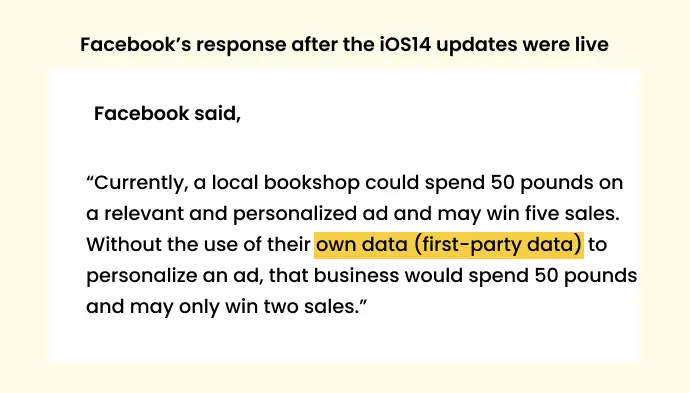
You can read our blog – Facebook is just an advertising tool. Not your Data host.
The data with ad platforms became negligible due to the above. And that resulted in Facebook’s custom audience match rate dropping below 25%.
Step 2: Define Your Business Goals First
Before segmenting, ask: What outcome am I optimizing for?
Like if your goal is:
- Acquisition: Find high-intent first-time buyers.
- Retention: Re-engage lapsed customers.
- Revenue: Increase AOV among repeat buyers.
Each goal demands different segmentation logic. Your framework should align segmentation directly to campaign objectives; not the other way around.
Step 3: Identify and Prioritize Segments That Drive Value
Remember this one thumb rule: One segment might work for some businesses, but not for yours.
So identify and prioritize based on revenue potential and ease of targeting.
Here’s a simple way to score segments:
| Segment | Potential Value | Ease of Targeting | Priority |
| High AOV Repeat Buyers | High | High | Top Priority |
| Cart Abandoners | Medium | High | Top Priority |
| Window Shoppers (No Add to Cart) | Medium | Medium | Experiment |
| One-Time Discount Buyers | Low | High | Low Priority |
Pro tip: Start with segments that already have data volume and clear intent (e.g., add-to-cart visitors, frequent purchasers)
Step 4: Map Segments to Campaign Strategy
This is where segmentation turns into results.
For each segment, plan the message, channel, creative, and offer.
| Segment | Campaign Goal | Channel | Message / Offer Example |
| Cart Abandoners | Recovery | Meta Ads | “Still thinking? Here’s 10% off.” |
| Repeat Buyers | Loyalty | Email / Ads | “VIP Early Access – New Launch.” |
| Lapsed Customers | Win-back | Google + Meta | “We miss you! Free shipping on your next order.” |
| High-Value Customers | Retention | Meta + Email | “Exclusive bundle just for our top shoppers.” |
The tighter the mapping, the higher your ad personalization score and CTR.
Step 5: Automate, Test, and Refine
Audience Segmentation for your ecommerce businesses isn’t something that you fix one time and then it’s all done. When your customers move from one funnel to another, you will have to change your segment as well.
The best way to actually do this is to automate segment updates based on live events (e.g., Moved from Active → Lapsed after 90 days of inactivity). Then continuously test and optimize:
- A/B test creatives per segment
- Adjust budget allocation based on ROAS per audience
- Merge underperforming segments or split large ones for better precision
Pro tip: Monitor each segment’s performance weekly, sometimes, your top-performing segment this quarter won’t be the same next quarter.
Up next are direct hacks. Just read through and experiment on your ecommerce businesses.

20 Audience Segmentation Strategies for Ecommerce to Boost Ad & Campaign Performance
Use these proven segmentation strategies to tighten your targeting, cut ad waste, and scale ROAS across Meta, Google, and Email.
1. Retarget Cart Abandoners Within 24 Hours
Create a segment of users who added products to cart but didn’t checkout; retarget them with urgency-driven ads or a limited-time offer.
2. Exclude Recent Buyers From Prospecting Campaigns
Avoid ad waste by excluding customers who purchased in the last 7–14 days from your acquisition campaigns.
3. Run a Loyalty Campaign for High-AOV Repeat Buyers
Segment users who’ve purchased 3+ times or have an average order value 30% above your median; offer early access, bundles, or exclusive perks.
4. Win Back Lapsed Customers With Personalized Offers
Target users who haven’t purchased in 60–90 days; use “We miss you” ads or email flows with tailored discounts based on their past products.
5. Segment Visitors Based on Product Category Interest
Create dynamic segments for users who browsed specific categories (e.g., “Sneakers” or “Skincare”); retarget them with relevant product collections.
6. Prioritize High-Intent Visitors (Multiple Sessions or Deep Scrolls)
Use engagement metrics like session count or scroll depth; show them testimonial or social proof creatives to nudge purchase intent.
7. Run Geo-Targeted Campaigns for Location-Specific Offers
Segment customers by city or region; promote local events, free shipping zones, or weather-relevant products (e.g., rainwear in Chennai, hoodies in Delhi).
8. Separate Discount Buyers From Full-Price Buyers
Create two distinct segments; discount seekers get sale alerts; full-price buyers see premium or new-launch messaging.
9. Retarget High-Value Add-to-Cart Users Who Didn’t Convert
Filter for users who added products worth 20%+ above average cart value but didn’t purchase; retarget them with bundled or payment-flexibility offers.
10. Build Lookalike Audiences From Your Top 10% Customers
Use your best-performing customers (high frequency + high AOV) to build lookalikes in Meta and Google; expand only from profitable bases.
11. Trigger Upsell Campaigns Post-Purchase
Once a purchase event fires, push complementary product ads or personalized email recommendations based on the last product category.
12. Create Seasonal Segments and Automate Rotation
Tag users who bought during past festive seasons or sales; automatically trigger pre-sale or early-access ads 2–3 weeks before similar events.
13. Segment by Source Channel to Customize Creative
Visitors from Meta → lifestyle-driven creatives.
Visitors from Search → offer or conversion-driven creatives.
Email subscribers → community or loyalty-driven messaging.
14. Reward “Silent Loyalists” (High Frequency, Low Engagement)
Identify customers who buy often but don’t open emails or engage with ads; surprise them with personalized thank-you offers to boost retention.
15. Use Predictive Segments for Proactive Ads
Use tools like CustomerLabs or your CRM to identify users likely to churn or likely to purchase soon; trigger automated ads before they act.
16. Suppress Low-Value, Low-Intent Audiences
Stop wasting ad budget on visitors who bounced within 10 seconds or have 0 purchase history; exclude them from all remarketing flows.
17. Re-engage Subscribers Who Haven’t Clicked in 30 Days
For email + ad sync audiences, nudge dormant subscribers with fresh creative angles; product launches or new testimonials.
18. Segment Based on Device Type
Mobile users → short-form video or vertical creatives.
Desktop users → longer copy and carousel visuals.
19. Bundle Based on Purchase Frequency
Frequent buyers → Subscription or bundle campaigns.
One-time buyers → Single-product or flash-sale offers.
20. Automate Cross-Platform Syncing for Real-Time Segments
Push all segments (cart abandoners, high-value buyers, lapsed users, etc.) automatically to Meta and Google using your first-party data pipeline.
Start with 3–5 high-impact segments, track results weekly, and scale what drives the best performance. Each of these strategies can be implemented using your existing first-party data setup, hop on this call for the setup.
Integrating Segmentation Into Your Ad Campaign Workflow
If you wish to automate it and save your time, I’d suggest you to use tools like 1PD Ops to help you capture, unify, and sync audience segments instantly across Meta, Google, and email; no dev dependency, no data delay.
Now, let me give you a playbook – 7 steps to execute audience segmentation into your marketing stack
- Define the Segment Goal Before Launch
Start every campaign with a clear “who.” Acquisition (cold), Retargeting (cart abandoners), or Retention (repeat buyers).
- Create Separate Ad Sets for Each Segment
Don’t mix segments. Build individual ad sets — e.g., High AOV Buyers, Lapsed Users, Cart Abandoners — for cleaner performance tracking.
- Match Creatives to Intent
Align ad messaging to where users are in their journey — awareness, consideration, or conversion.
- Exclude Recent Buyers & Low-Intent Visitors
Save budget by removing recent purchasers or bounced users (<10 sec sessions) from all prospecting and retargeting flows.
- Automate Lifecycle Triggers
Set rules like:
- 7 days after purchase → Upsell campaign
- 45 days inactive → Reactivation
- 90 days inactive → Win-back
- Sync Segments Across Platforms via 1PD Ops
Push dynamic audiences to Meta Custom Audiences, Google Ads, and email platforms, ensuring consistent targeting everywhere.
- Optimize Budgets Weekly by Segment ROAS
Scale high-performing audiences, pause weak ones, and refresh data regularly to prevent audience fatigue.
Segmentation doesn’t end with data, it starts performing when plugged into your campaign workflow. Use 1PD Ops to keep your audiences dynamic, synced, and always aligned with ad intent.
Once your campaign is set, you should track the numbers. So what should you really look at instead of vanity metrics?
What Metrics to Look at to Measure Audience Segmentation Success?
Track these metrics weekly to know which segments deserve more spend and which ones need pruning.
- ROAS by Segment – Measure ad return per audience; scale the ones with the highest ROAS.
- Conversion Rate per Segment – Track how efficiently each segment converts clicks into sales.
- Cost per Acquisition (CPA) – Identify which audience delivers the cheapest conversions without hurting quality.
- Average Order Value (AOV) – See if segmented campaigns are driving higher-value purchases.
- Repeat Purchase Rate (RPR) – Measure retention impact; strong segments bring customers back faster.
- Churn / Inactivity Rate – Track how fast customers drop off after their last interaction; adjust win-back timing.
- CTR & Engagement Rate – Use these to test ad-message relevance for each segment before scaling spend.
Pro Tip: To keep your tracking intact, use 1PD Ops tools like CustomerLabs to automatically sync conversion events and revenue data from Meta, Google, and your store; so you can view segment-level performance in real time.
Let’s look at the pitfalls that you should prevent from happening while planning, executing or any stage.
Common Audience Segmentation Mistakes (and How to Fix Them Fast)
- Creating Segments Without a Goal: Always tie every segment to a campaign objective: Acquisition, Retargeting, or Retention.
- Over-Segmentation: 5–7 core segments are enough. Too many = messy data + diluted budget.
- One-Message-Fits-All Creatives: Never reuse ad copy across segments. Each audience deserves its own angle and offer.
- Ignoring Data Freshness: Refresh segments weekly. Remove users who converted or went inactive.
- Skipping Exclusions: Always exclude recent buyers and low-intent traffic to avoid wasted spend.
- Not Measuring at Segment Level: Track ROAS, CPA, and RPR for each segment separately, not just campaign totals.
- Poor Tracking Setup: Missed events = bad segments. Ensure all key user events are tracked via 1PD Ops for clean, real-time data.
Why should you act now?
Google has time and again iterated that you have to leverage first-party data for optimized ad campaigns.
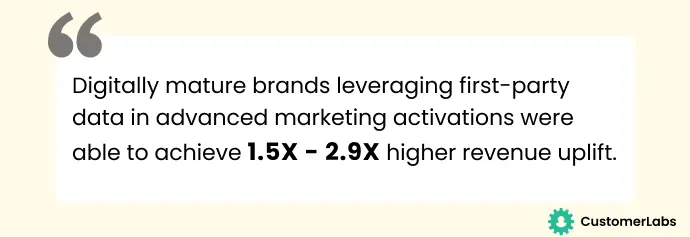
Also, Google, in collaboration with BCG, has conducted a study and classified businesses into four stages based on the digital marketing maturity model and how smartly they use their own data.
What is Digital Marketing Maturity Model?
Digital marketing maturity refers to the ability of a business to consistently use technology to deliver the most relevant content to consumers at various touch points along the purchase journey, also referred to as multi-moment consumer contact.
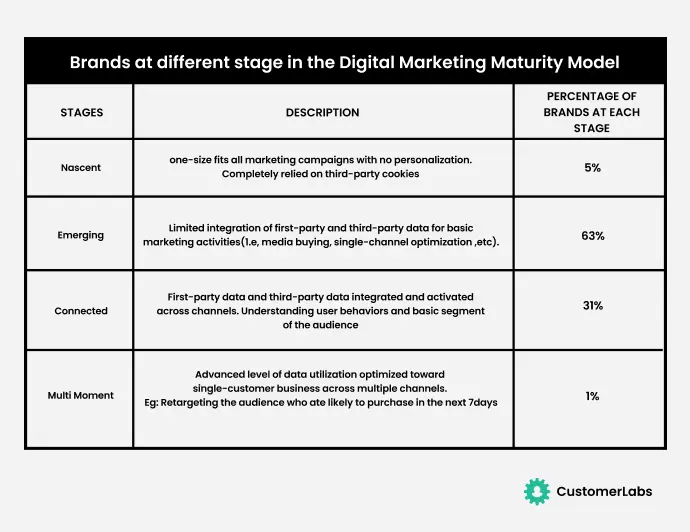
Unfortunately, 63% of e-commerce brands are stuck in stage 2 of digital marketing maturity.
In stage 2 of the Digital Marketing Maturity Model, the marketers are powering Facebook pixel with First-Party data to run their ad campaigns. It implies the understanding of First-Party data among the marketers is still email id, contact number, or any form-filled data (known user data).
However, as explained above, first-party data is beyond that. Anybody who stumbles on your website is your first-party data. As mentioned, generally, 98% of website visitors are anonymous visitors. They could have landed on your website from a Google ad, Facebook ad, social media meme, newspaper ad, television ad, or organic search.
Majority of the anonymous website visitors are the high-intent audience who can be nurtured and pushed to the bottom of the funnel. But these anonymous users are stuck in the middle of the funnel.
Even 1-2% of conversions can significantly improve the bottom-of-the-funnel audience and add more revenue to your balance sheets.
Read how activating the middle of the funnel audience can improve the ROAS by upto 2X times!
Activate and segment your mid-funnel: Stage 2 → Stage 3 of Digital Marketing Maturity
Move away from old-school segmentation to advanced smart audience segmentation.
Segmenting the audience based on the demographics and the default segments available on the advertising platforms like added to cart and checkout made are so old school.
And segmenting them based on their user journey and engaging them with relevant tailored messaging takes the customer a step closer to conversion.
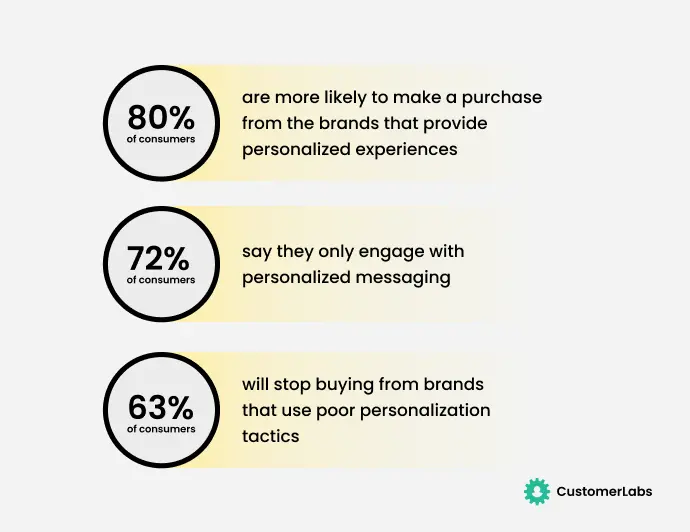
Middle of the funnel segmentation: “Personalized engagement”
Some of the mid-funnel segment examples to whom you can run personalized ads are
- Cart_abandoned for more than 30 days
- Product_viewed_not_ added_to_cart
- Product _viewed_more than three times
- Segment the users who have wishlisted for more than ten products
Segment the users who are first-time visitors and provide them “newbie discount codes”India’s largest e-commerce fashion brand, W for Woman, implemented first-party data strategies and activated its mid-funnel audience. They saw increased match rates beyond 80% and tripled their ROAS. Check out to know W for Woman story.
Bottom of the funnel segmentation: “One step closer to conversion”
- Added_to_cart_not purchased
- Added_to_cart_before 30 days
- Product wishlisted for more than seven days
- Product wishlisted less than three days
Audience re-activation segmentation: “No more 180 days cookie retention fear”
You may have an audience built up during the festive or the sales season, and with no fear of 90 or 180 days of cookie retention, you can bring them back because you own your customer behavior data.
- Bring the Xmas and easter customers back to the funnel
- Bring the Cyber Monday sales audience back to the funnel
- Reactivate & nurture one-time buyers who purchased one year ago.
Build advanced audience segments & push them to various ad platforms in real-time using CustomerLabs’ advanced audience segmentation feature.
Stage 4 of the Digital Marketing Maturity Model is not really far – Mulitmoment
E-commerce marketers can predict and model the users based on their purchase history. One of our e-commerce clients has been segmenting and retargeting their users based on their purchase history:
- Female customers who had higher cart values were retargeted for cosmetic products
- Customers who purchased top-wear clothes were retargeted for bottom-wear
- Predict the possible next purchase of customers based on their purchase history
- Predict the first purchase of a website visitor based on their website behavior
- Segmented the plus-size customers based on the PDP (Product Detail Page) visits.
Future Trends in E-commerce Segmentation & Ads
1. Real-Time Dynamic Segmentation
The future of segmentation is instant. As users browse, click, or abandon carts, their segment updates automatically; triggering personalized ads or offers in real time. No more batch updates or manual uploads; automation drives agility and precision.
2. AI-Powered Audience Predictions
Machine learning will identify patterns that humans can’t — predicting who’s most likely to buy, churn, or upgrade. These predictive segments will help marketers move from reactive to proactive campaigns, reaching customers before intent fades.
3. First-Party Data as the New Currency
With third-party cookies disappearing, first-party data becomes every brand’s growth engine. Using 1PD Ops tools like CustomerLabs, brands can collect, enrich, and activate their own customer data pipelines, powering accurate targeting without relying on external platforms.
4. Omnichannel Segmentation Sync
Customers don’t live in one channel and soon, neither will your segments. The next wave of segmentation will unify audiences across Meta, Google, email, WhatsApp, and even SMS — ensuring every touchpoint delivers a consistent experience.
5. Micro & 1:1 Personalization at Scale
The days of “broad targeting” are ending. Marketers will use micro-segments built from behavior, value, and emotion to deliver one-to-one personalization — product recommendations, messages, and creatives tailored to each user’s intent.
6. Privacy-Centric Targeting Models
Data privacy regulations (GDPR, DPDPA, CCPA) will redefine how segments are built and shared. The winning brands will prioritize consent-based tracking, transparent data collection, and privacy-safe activation through secure first-party data systems.
7. Automated Ad Decisioning
AI will soon take over the heavy lifting, automatically shifting budgets, swapping creatives, or pausing underperforming segments based on live ROAS and engagement data. This means faster decisions, better efficiency, and fewer wasted impressions.
Conclusion
Smart segmentation isn’t about creating more lists, it’s about creating more clarity. Start every campaign with a clear goal and build only 5–7 meaningful segments that reflect your real customer journeys.
Use 1PD Ops tools like CustomerLabs to unify first-party data, build dynamic segments, and sync them across Meta, Google, and email in real time. The faster your data flows, the sharper your targeting gets.
Finally, keep testing, learning, and optimizing. Scale segments that drive results, retire the rest. Personalize every ad experience and measure what truly matters; ROAS, AOV, and repeat purchases. The brands that win are those that know exactly who they’re talking to.
Setup 1PD Ops setup for free or feel free to discuss with our product experts to see if 1PD Ops is right for you.
